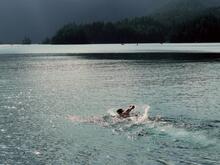Perhaps it is not surprising that Leo Baldwin grew-up to be a principal engineer for Amazon. He is currently working on the optical sensing systems for their automated delivery vehicle that resembles a picnic cooler on wheels. While still in grade school, Leo started to tinker with optical instruments. As a kid, he often worked on projects in his father’s basement, taking apart and putting back together or building anything that grabbed his curiosity, including a pair of binoculars and making a water drop microscope. As a young man, it was a vacuum pump he scrounged and rebuilt that won him his first job in a physics lab. It was that job, and the co-op students he met there, that convinced him to leave an engineering major at another institution and study applied physics at the University of Waterloo. (Good choice, Leo!)

 You don’t need to talk to Leo long to notice that he is one of those people who fully embraces life. During our recent video chat, he sat comfortably on a leather couch in a wood-paneled room, fingering a collection of camera lenses. Life in Seattle, Washington suits Leo. He lives close to the water and likes to swim in his pool, nearby lakes, and sometimes the Puget Sound. He often paddles around in an inflatable kayak that he and his wife throw in the back of their roadster to get to nearby lakes or the Puget Sound. Then there are the lenses and cameras. Photography is a lifelong hobby that has served Leo well as the basis for a career in optics and lens design.
You don’t need to talk to Leo long to notice that he is one of those people who fully embraces life. During our recent video chat, he sat comfortably on a leather couch in a wood-paneled room, fingering a collection of camera lenses. Life in Seattle, Washington suits Leo. He lives close to the water and likes to swim in his pool, nearby lakes, and sometimes the Puget Sound. He often paddles around in an inflatable kayak that he and his wife throw in the back of their roadster to get to nearby lakes or the Puget Sound. Then there are the lenses and cameras. Photography is a lifelong hobby that has served Leo well as the basis for a career in optics and lens design.
It was Leo’s passion for photography that led him to a career-defining opportunity in nearby Midland, Ontario. As he was finishing his undergraduate degree at Waterloo, Leo and a fellow physics major (Hi Jim!) learned that the renowned Germany camera company, Leica, had a design and manufacturing facility in Midland, ON. Leo and his friend agreed that was where they should get jobs, which they both did! As Baldwin describes it, he was amazed to be working with people referenced in his textbooks. The company paid for Baldwin to take a Masters program in Modern Optics at the University of Rochester, where he met more optics and imaging trailblazers. Leo Baldwin spent the next two decades building up skills and knowledge in an array of industries, including glass inspection, semiconductor laser processing, and solar energy before being offered an incredible opportunity to work at Amazon to design the cameras (6!) for their Fire Phone. Except for a 9-month stint at Go Pro, Leo has enjoyed working for this world-renowned company for over a decade, leaving his mark on dozens of projects developed at Amazon.
Baldwin is one of those lucky people who has found a way to build a successful career that is centered squarely on his passions, something he encourages and recommends. When asked if he had any advice for an undergraduate today, Leo said “If you are interested in something, add it to your program.
Why only study within your program? The best stuff is happening at the interface!
(Leo added optometry and economics to his undergrad physics degree.) Baldwin, an inventor and innovator with nearly 100 patents, added that everyone should learn computer programing and basic CAD (Computer Aided Design) skills. With the ubiquity of 3D printing, CAD skills are as fundamental in an engineering environment as word-processing skills are in an office environment.
Leo’s fondest memories of his time on the University of Waterloo campus are ones that include his time with his professors. John Vanderkooy, a favorite “awesome teacher who tied everything together” came immediately to mind. Leo remembered classes with Dr. Vanderkooy where he discussed his consulting work for Star Wars producer, George Lucas. “All the cool audio stuff we think came from George Lucas actually came from John Vanderkooy and Stan Lipshitz” Baldwin said. Then there’s Larry Smith, distinguished teacher in Economics. Larry and Leo became good friends when Baldwin took Smith’s courses. Leo remembers Larry as being “an amazing advocate for student innovation”. Years later, Larry Smith would publish a book called “How to Have a Great Career: Find Your Passion, Achieve Your Goals and Love What You Do”. Perhaps he shared an early draft with his friend, Leo Baldwin.






